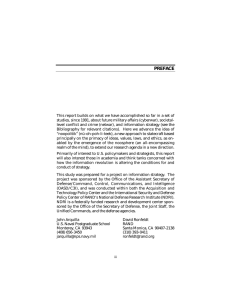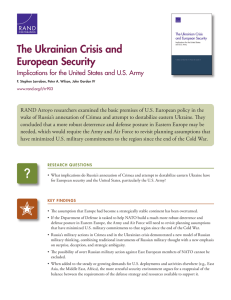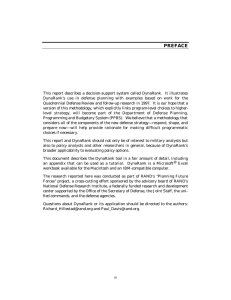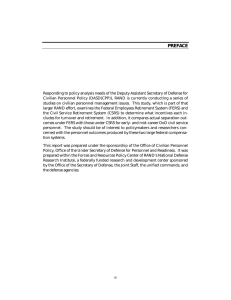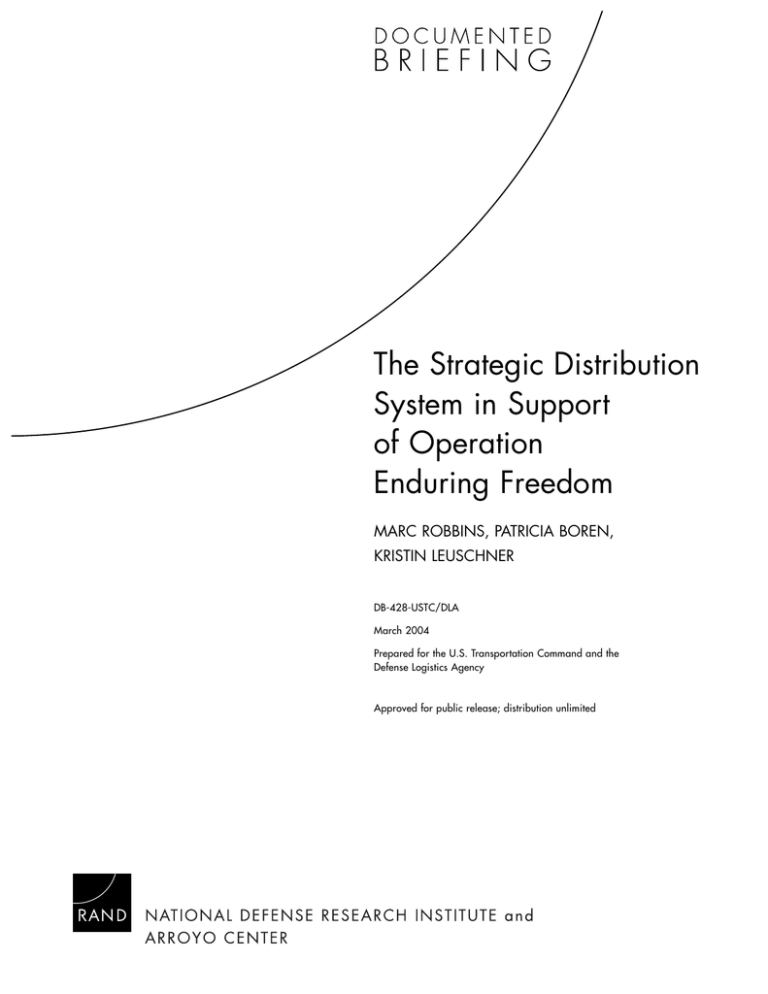
The Strategic Distribution
System in Support
of Operation
Enduring Freedom
MARC ROBBINS, PATRICIA BOREN,
KRISTIN LEUSCHNER
DB-428-USTC/DLA
March 2004
Prepared for the U.S. Transportation Command and the
Defense Logistics Agency
Approved for public release; distribution unlimited
The research in this briefing was sponsored by the U.S. Transportation Command and the
Defense Logistics Agency. The research was conducted in the RAND National Defense
Research Institute and RAND Arroyo Center, both federally funded research and
development centers, the first supported by the OSD, the Joint Staff, the unified commands,
and the defense agencies under Contract DASW01-01-C-0004 and the second by the
United States Army under Contract DASW01-01-C-0003.
ISBN 0-8330-3506-1
The RAND Corporation is a nonprofit research organization providing objective analysis
and effective solutions that address the challenges facing the public and private sectors
around the world. RAND’s publications do not necessarily reflect the opinions of its research
clients and sponsors.
R® is a registered trademark.
© Copyright 2004 RAND Corporation
All rights reserved. No part of this book may be reproduced in any form by any electronic or
mechanical means (including photocopying, recording, or information storage and retrieval)
without permission in writing from RAND.
Published 2004 by the RAND Corporation
1700 Main Street, P.O. Box 2138, Santa Monica, CA 90407-2138
1200 South Hayes Street, Arlington, VA 22202-5050
201 North Craig Street, Suite 202, Pittsburgh, PA 15213-1516
RAND URL: http://www.rand.org/
To order RAND documents or to obtain additional information, contact
Distribution Services: Telephone: (310) 451-7002;
Fax: (310) 451-6915; Email: order@rand.org
SUMMARY
In a tale of war the reader’s mind is filled with the fighting. The battle . . .
excites imagination and commands attention. . . . The long trailing line of
communications is unnoticed. . . . Victory is the beautiful, bright-colored
flower. Transport is the stem without which it could never have blossomed.
Yet even the military student, in his zeal to master the fascinating
combinations of the actual conflict, often forgets the far more intricate
complications of supply . . . In savage warfare in a flat country the power of
modern machinery is such that flesh and blood can scarcely prevail, and the
chances of battle are reduced to a minimum. Fighting the Dervishes was
primarily a matter of transport. The Khalifa was conquered on the railway.2
The Defense distribution system is the part of the Department of Defense (DoD)
that manages the storage and movement of supplies to military customers at
home and around the world. Unfortunately, throughout the 1990s, the system’s
performance was often poor and unreliable, and customers were losing
confidence in it. As a result, in early 2000, leaders of the U.S. Transportation
Command (TRANSCOM) and the Defense Logistics Agency (DLA) agreed to
embark jointly on the Strategic Distribution program (SD) to deliver more
reliable and cost-effective service to DoD forces and organizations in the United
States and around the globe.3 This documented briefing tells the story of SD’s
inception and achievements, focusing in particular on how well that system met
the challenge of Operation Enduring Freedom (OEF).
AFTER THE COLD WAR, PROBLEMS IN DEFENSE
DISTRIBUTION BECAME APPARENT
Support to the Persian Gulf in 1990 during Operation Desert Storm provides an
example of the kinds of problems facing the Defense distribution system
throughout the 1990s. Although combat performance in this operation has been
justifiably esteemed, there were significant problems in logistics support for the
war. Distribution times were long, variable, and undependable, due largely to
inefficient processes, clogged ports, and a myriad of other problems. The result
____________
2Winston
S. Churchill, The River War: An Account of the Reconquest of the Soudan, New York:
Carroll and Graf Publishers, 2000 (originally published 1902), pp. 162–163.
3Before
May 2002, SD was known as the Strategic Distribution Management Initiative (SDMI).
vii
was that materiel often took more than 35 days simply to get out of the United
States. Problems with the global distribution system persisted throughout the
1990s, despite individual service-specific successes (e.g., the Army’s Velocity
Management Initiative, the Air Force’s Lean Logistics, and the Marine Corps’
Precision Logistics).
The Defense distribution system was not structured to meet the needs of its
customers effectively or efficiently. Inventory was scattered at dozens of
locations in the United States and around the world, effectively making each
supply point a “worldwide distributor” and removing the benefits of economies
of scale. Whereas the best distribution practices emphasize streamlined flows
and a minimization of stops, queues, and handling, Defense distribution modes
tended to suffer from significant delays as materiel sat in ports and transit hubs.
The unreliability of the military service caused many customers to turn to
better—and more expensive—distribution modes, such as FedEx and Worldwide
Express. Decreasing customer confidence was especially a problem for military
air. The loss of customers contributed to the underuse of military air cargo
capacity and caused reverberations for the wartime readiness of air crews and
ground elements, which rely on peacetime missions (and the funds they bring in)
to support their wartime training.
THE GOAL OF SD IS FAST, RELIABLE, COST-EFFECTIVE
SUPPORT TO CUSTOMERS IN PEACE AND WAR
It was these disturbing trends that led leaders of TRANSCOM and DLA to join
forces in 2000 to seek improvements, with RAND’s assistance. The result of this
collaboration, SD, builds upon RAND’s similar efforts for the Army’s Velocity
Management (VM) initiative. Like VM, SD was founded on the principle of
partnership among stakeholders and process owners. As in VM, RAND is
playing a central role in making the case for change, assembling and integrating
data to provide a comprehensive view of processes, and using those data to build
metrics, reports, and analytical products to support improvement efforts. One of
RAND’s contributions to the SD effort has been a DoD-wide “distribution
enterprise” database. This database provides a means of looking
comprehensively into the performance of DoD’s many distribution modes,
including commercial services as well as military air distribution.4
____________
4SD’s
focus, and that of the “distribution enterprise” database, is “sustainment” materiel
requisitioned through the wholesale system. It does not cover deployments or materiel
viii
One of the major challenges for the Defense distribution system is to provide fast,
reliable, cost-effective support to customers despite the unpredictability and
volatility of customer demand, which can surge or decline tremendously from one
year to the next. To meet this challenge, SD has adopted a strategic vision built
around what are known as the “3 S’s”—stock positioning, scheduled movements,
and synchronization. Stock positioning means putting inventory in the right
place; for example, within the United States, SD seeks to maximize the amount of
cargo at two Strategic Distribution Platforms located, respectively, on the East and
West Coasts. Scheduled movements from these distribution centers ensure that
trucks leave at a certain time each day and arrive at their destination at a set time.
Further, these steps are synchronized to minimize queuing and hold times—all
the non-value-adding elements that make performance slow and unreliable.
SD’s initial efforts have yielded positive results, including the consolidation of
inventory at the East Coast and West Coast U.S. locations, the expansion of stock
points closer to customers in Europe, and the establishment of new customers
and routes for scheduled trucks. These improvements will yield savings to
taxpayers as well as better service to forces. DLA estimates that these actions
will save at least $120 million over the five-year period 2003–2007. In addition,
improved military air distribution is matching commercial performance. A twopart example of the improvement is shown in Figure S.1, which displays
monthly average end-to-end distribution times to forces deployed in Bosnia (left)
and Kuwait (right) from January 1997 through August 2001.
As indicated by the chart on the left, not only did the monthly average end-toend times drop sharply after the SD began, but the variability of the process was
also significantly reduced. The chart on the right shows similar improvement in
service to Kuwait, but adds an interesting twist. In this case, Army leaders had
been so dissatisfied with the length and variability of performance that, in
September 1999, they decided to contract with a commercial firm for air
deliveries. This shift did result in improved service, as shown. However, leaders
in SD and Central Command later decided that it would be better if Kuwaitbound cargo were once again carried by military air—but only if service and
price were not harmed. Kuwait cargo reverted to military air carriers in April
2001, and the chart shows that, during the initial months after this switch,
“pushed” forward, or certain bulk commodities like fuel and food. Also, the focus to date has
been on the distribution elements of the larger DoD supply chain. It does not take on the issues
of supply availability or the incidence and length of backordered supplies. Also, it does not track
the movement of personal cargo, such as luggage, household goods, or mail.
ix
SD Is Improving Military Air Distribution
End-to-end times in days
35
35
Pre-SDMI
30
30
Military air
Military air
Military air
25
25
20
20
15
15
10
10
5
5
0
Pre-SDMI
SDMI
98
99
00
0
01
Army - Bosnia
Commercial
shipper
SD
Military
air
98
99
00
01
Army - Kuwait
A3756-21 03/03
Figure S.1—End-to-End Times for Military Air Distribution to Bosnia and
Kuwait, January 1997–August 2001
military air performance matched (or slightly outperformed) that of the
commercial carrier.
But then came September 11. The onset of Operation Enduring Freedom meant
that virtually all military aircraft normally used in distribution were given to
other missions, such as supporting deployment to and movement within the
theater of operations. How well would the Defense distribution system perform
its mission during wartime, in terms of both supporting deployed forces in the
field and maintaining service to the worldwide customer base?
SD MET THE CHALLENGES OF OPERATION ENDURING
FREEDOM
Through the strategic management of resources, the Defense distribution system
was able to meet the challenges of OEF’s first three months.5 To maintain service
____________
5Combat
operations began over Afghanistan on October 7, 2001, led by Air Force and Navy
carrier-based bombers, and supported by Army special operations forces operating out of
x
to worldwide customers, commercial 747s were hired to take on routes
previously flown by military aircraft, virtually all of which were removed from
non-OEF service.6 Figure S.2 shows the impact of this move on support to the
customer. The bars show the end-to-end times for the three major commands
(European, Pacific, and Central) averaged together, while the darker and lighter
lines in the background represent, respectively, the drop in the number of
shipments carried by military air and the increase in shipments carried by
commercial aircraft before and after the beginning of OEF. The consistent level
of the bars demonstrates that, despite the disruptions of OEF, there was no
noticeable impact on support to customers. This was the case even though the
Strategic Management of Air Resources
Successfully Maintained Customer Support
End-to-end time in days
Number of shipments in 1000s
35
35
30
30
25
20
60% increase
in tonnage
Average end-to-end time for European,
Pacific, and Central Commands
25
20
15
15
10
10
5
5
0
Jan.
Mar.
May
Jul.
Sept.
Nov.
0
2001
A3756-24 03/03
Figure S.2—Average End-to-End Times for European, Pacific, and Central
Commands Before and After the Onset of OEF
Uzbekistan and elsewhere. The Taliban regime collapsed, and Kabul was liberated on November
16, 2001. This document analyzes support to forces deployed to the theater in the first three
months of operation (October–December 2001). Operations continued past that period but
entered a different phase, with the buildup of a more mature theater structure and more reliance
on a theater distribution system. The follow-on phase of OEF operations will be analyzed in a
future document that investigates strategic distribution to this more “mature phase” of OEF and
the run-up to and actions during Operation Iraqi Freedom.
6Cargo
was also diverted to surface modes when it made sense to do so.
xi
volume of materiel carried through these channels increased by 60 percent
following September 11.
To support forces engaged in OEF, TRANSCOM developed plans tailored to the
specific needs of each type of force engaged in the fight. For the Air Force, the
center of gravity in the first three months of OEF was Diego Garcia (in the Indian
Ocean), where 18 B-1 and B-52 bombers were stationed. This small force was
critical to the success of OEF; thus, the Air Force had a major need for fast and
reliable movement of critical parts to keep all the bombers as operational as
possible. Premium service from a commercial carrier like Worldwide Express was
not an option, since there is no commercial service to Diego Garcia. Therefore, the
Air Force negotiated with TRANSCOM and its Air Mobility Command about the
level and speed of service needed. By synchronizing each step and bringing in
commercial charters to fly routes generally flown by military aircraft between
military ports, Air Mobility Command was able to achieve overall times to Diego
Garcia that compared favorably to Worldwide Express performance and reduced
end-to-end distribution times from 14 days to 9.
For the Navy, the main concern was to maintain at least the traditional level of
support coming from the United States even as demand quadrupled with an
increase in carrier battle groups in theater from one to four. Because the Navy
operates within the area all the time, it has a well-developed base of operations
in the Persian Gulf and was able, from the earliest moments of OEF, to apply
large, sustained combat force over Afghanistan from attack aircraft launched
from aircraft carriers in the Arabian Sea. The Navy’s need for dependable
service was answered through increased reliance on commercial charters flying
within the “military air” system. And the large carrying capacity of the 747s
allowed for a surge in capacity even while the level of responsiveness was
maintained. Total cargo carried by commercial charters within the military air
system went from 463 tons in June–August 2001 to over 2,000 tons in October–
December, compared to increases from 333 to 727 tons for military aircraft.
Support for Army forces operating out of Karshi Khanabad in Uzbekistan posed
a different kind of challenge. Karshi Khanabad is a bare-bones base with no
history of U.S. deployments; its location was about as far as one can get from
established U.S. support bases. The Army needed fast and dependable
distribution to its deployed support structure, especially because its special
operations forces supply activity was responsible for the needs of an unusually
wide array of military units.
xii
By relying upon the SD principles of stock positioning, schedules, and
synchronization, TRANSCOM and DLA were able to provide the necessary level
of support to the Uzbekistan deployment. Figure S.3 shows average end-to-end
distribution time for Army forces deployed to Karshi Khanabad for the period of
October–December 2001. Times, from request date to receipt, averaged about 16
days. In this case, there is no comparison of before and after, since the Army had
never before deployed to Uzbekistan. But we can put these times into
perspective by comparing the distribution time for Uzbekistan to times for other
Army deployments that were using the Defense distribution system at roughly
equivalent stages of deployment. The figure shows the times experienced by
Army deployments to Kosovo, Bosnia, and Kuwait in the first months after
setting up operations. Support to the Uzbekistan deployment compared
favorably to the early deployment times of other Army operations—despite the
much greater distance, the greater number of cargo “touches,” and channel
congestion. Supplies sent to Uzbekistan required at least two transloadings,
compared to one (such as to Kosovo and Bosnia) or none (to get to Kuwait).
Unlike distribution during times of peace, shipments to Uzbekistan during OEF
had to contend with the absence of any organic airlift capability. Finally, much
Uzbekistan Times Compared Well With
Early Stages of Other Deployments
Uzbekistan
16
Kosovo
20
Bosnia
17
Kuwait
17
0
10/01 – 12/01
Pre-SD 8/99 – 10/99
Pre-SD 5/97 – 7/97
Pre-SD 5/97 – 7/97
5
10
15
20
25
End-to-end distribution time in days
A3756-29 03/03
Figure S.3—End-to-End Times for Early Stages of Uzbekistan
and Other Deployments
xiii
of the beginning-to-end time to Uzbekistan was accounted for by delays in the
receiving units’ ability to receive and process the incoming materiel, after it had
left the strategic distribution system.
AFTER THE FALL OF THE TALIBAN
Operation Enduring Freedom was only the first challenge faced by the Defense
distribution system after September 11, 2001. Since then, the system has been
operating at virtually peak capacity at the same time that it is trying to
implement the Strategic Distribution vision. In this new world, new areas and
new challenges are taking on greater prominence:
• Integrating the strategic elements of the Defense distribution system with
theater processes will become more prominent.
• Developing an integrated management to control the entire distribution
process will become even more critical.
• Balancing the needs for deployment and sustainment across shared resources
(ports, aircraft, etc.) will become more pressing.
• Improving the quality of in-transit visibility, such as through the use of radio
frequency tags, will help deployed forces to better manage their needs.
• The continued reliance on commercial sources to carry cargo from Air
Mobility Command ports will necessitate clearer policies on the division of
labor between organic and commercial craft and how to manage the Civil
Reserve Air Fleet (CRAF).
• The fact of U.S. forces increasingly dispersed across the globe suggests the
need for expanding our view of stock positioning and balancing the
usefulness of U.S.-based stocks at Strategic Distribution Platforms and
theater-based stocks.
xiv

